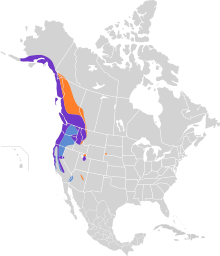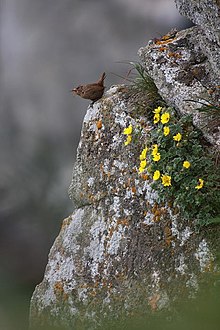Pacific wren
This article includes a list of general references, but it lacks sufficient corresponding inline citations. (October 2010) |
| Pacific wren | |
|---|---|

| |
| Scientific classification | |
| Domain: | Eukaryota |
| Kingdom: | Animalia |
| Phylum: | Chordata |
| Class: | Aves |
| Order: | Passeriformes |
| Family: | Troglodytidae |
| Genus: | Troglodytes |
| Species: | T. pacificus
|
| Binomial name | |
| Troglodytes pacificus Baird, 1864
| |

| |
| Synonyms | |
|
Nannus pacificus | |
The Pacific wren (Troglodytes pacificus) is a very small North American bird and a member of the mainly New World wren family Troglodytidae. It was once lumped with Troglodytes hiemalis of eastern North America and Troglodytes troglodytes of Eurasia as the winter wren.
It breeds along the Pacific coast from Alaska to California and inland as far as Wyoming and the Black Hills of South Dakota. It migrates through and winters across the western half of the United States and Canada.
The scientific name is taken from the Greek word troglodytes (from trogle a hole, and dyein to creep), meaning 'cave-dweller', and refers to its habit of disappearing into cavities or crevices whilst hunting arthropods or to roost.
Description[edit]
Rufous brown above, richly colored below, barred with darker brown and dusky, even on wings and tail. The bill is dark brown, the legs pale brown. Young birds are less distinctly barred.
Taxonomy[edit]
By studying the songs and genetics of individuals in an overlap zone between Troglodytes hiemalis and T. pacificus, Toews and Irwin (2008)[2][3] found strong evidence of reproductive isolation between the two. It was suggested that the pacificus subspecies be promoted to the species level designation of Troglodytes pacificus with the common name of ‘Pacific wren’. By applying a molecular clock to the amount of mitochondrial DNA sequence divergence between the two,[4] it was estimated that Troglodytes pacificus and Troglodytes troglodytes last shared a common ancestor approximately 4.3 million years ago, long before the glacial cycles of the Pleistocene, thought to have promoted speciation in many avian systems inhabiting the boreal forest of North America.[5]
Ecology[edit]
The Pacific wren nests mostly in coniferous forests, especially those of spruce and fir, where it is often identified by its long and exuberant song. Although it is an insectivore, it can remain in moderately cold and even snowy climates by foraging for insects on substrates such as bark and fallen logs.
Its movements as it creeps or climbs are incessant rather than rapid; its short flights swift and direct but not sustained, its tiny round wings whirring as it flies from bush to bush.
At night, usually in winter, it often roosts, true to its scientific name, in dark retreats, snug holes and even old nests. In hard weather it may do so in parties, either consisting of the family or of many individuals gathered together for warmth.
For the most part insects and spiders are its food, but in winter large pupae are taken and some seeds.
Breeding[edit]

The male builds a small number of nests. These are called "cock nests" but are never lined until the female chooses one to use. The normal round nest of grass, moss, lichens or leaves is tucked into a hole in a wall, tree trunk, crack in a rock or corner of a building, but it is often built in bushes, overhanging boughs or the litter which accumulates in branches washed by floods. Five to eight white or slightly speckled eggs are laid in April, and second broods are reared.
A particular facet of the Pacific Wren is that the males use intricate vocalizations to attract females for mating. Pacific Wrens are songbirds and the songs are used for mating purposes as well as for territorial displays. In British Columbia, Canada, male Pacific Wren have been observed to adapt their songs in the presence of highway noise. Pacific Wrens are widely known for their variety and complexity of song. In adaptation to the noise of freeway traffic, male Pacific wrens were observed to change the overall length of their songs. However, other changes in song variation and individual syllable length could not be concluded.[6]
A variation in reproduction success has been observed at higher altitudes. In the forests of British Columbia, at higher altitudes, in 2003-2004 there was a decline in breeding compared with lower altitudes of habitation for the Pacific Wren. Specifically, the length of breeding season was shorter and the survival rates of nests were lower. However, other factors such as incubation length and the total number of eggs in each nesting attempt showed no variation due to elevation. Although the Pacific Wren overall lacked adaptation to higher altitudes, there was a small percentage of Pacific Wrens that were able to successfully reproduce at these higher elevations. [7]
Adaptations in breeding patterns within urban landscapes were observed in the Seattle, Washington area and its surrounding forests. In the developing urban ecosystems of the city, Pacific Wren fled and relocated to nearby forests. Due to this change of location, breeding success for those Pacific Wren declined significantly. The proportion of wrens returning to the same urban nest in the greater Seattle, Washington area was in some cases observed to be as low as 0%. In this case, the Pacific Wren’s relocation in conjunction with its inability to cultivate a successful new nesting site is what contributed to the decline in reproduction. [8]
In contrast, a close relative of the Pacific Wren, the Bewick’s wren has been highly successful at thriving in certain urban environments. This stands in polarity to the Pacific Wren's diminished numbers in urban areas. Moreover, the Bewick’s Wren, otherwise known as Thryomanes bewickii, has been observed to interact aggressively with the Pacific Wren. However, the exact reasons for Bewick Wren’s success vs. Pacific Wren’s diminishing numbers in urban areas are unclear. Overall, observations are in favor of the hypothesis that urban landscapes foster aggressive and combative interactions between native species.[9]
Cultural depictions[edit]
The 1999 U.S. postage stamp Pacific Coast Rain Forest sheet features a stamp with a "winter wren (Troglodytes troglodytes)"; this bird was subsequently classified as the Pacific wren.[10] The narrator of "The White Seal" story of The Jungle Book by Rudyard Kipling is Limmershin, a "winter wren",[11] actually the Pacific wren.
References[edit]
- ^ "BirdLife International Species factsheet: Troglodytes troglodytes". BirdLife International. Retrieved 2007-11-20.
- ^ Holt, Ben G.; Lessard, Jean-Philippe; Borregaard, Michael K.; Fritz, Susanne A.; Araújo, Miguel B.; Dimitrov, Dimitar; Fabre, Pierre-Henri; Graham, Catherine H.; Graves, Gary R.; Jønsson, Knud A.; Nogués-Bravo, David; Wang, Zhiheng; Whittaker, Robert J.; Fjeldså, Jon; Rahbek, Carsten (2013). "An Update of Wallace's Zoogeographic Regions of the World". Science. 339 (6115): 74–78. Bibcode:2013Sci...339...74H. doi:10.1126/science.1228282. PMID 23258408. S2CID 1723657.
- ^ Toews, David P. L.; Darren E. Irwin (2008). "Cryptic speciation in a Holarctic passerine revealed by genetic and bioacoustic analyses". Molecular Ecology. 17 (11): 2691–2705. Bibcode:2008MolEc..17.2691T. doi:10.1111/j.1365-294X.2008.03769.x. ISSN 0962-1083. PMID 18444983. S2CID 8488125.
- ^ Drovetski, S. V.; R. M. Zink; S. Rohwer; I. V. Fadeev; E. V. Nesterov; I. Karagodin; E. A. Koblik; Y. A. Red'kin (2004). "Complex biogeographic history of a Holarctic passerine" (PDF). Proceedings of the Royal Society B: Biological Sciences. 271 (1538): 545–551. doi:10.1098/rspb.2003.2638. ISSN 0962-8452. PMC 1691619. PMID 15129966. Archived from the original (PDF) on 2010-06-16.
- ^ Weir, J. T.; D. Schluter (2004). "Ice sheets promote speciation in boreal birds". Proceedings of the Royal Society B: Biological Sciences. 271 (1551): 1881–1887. doi:10.1098/rspb.2004.2803. ISSN 0962-8452. PMC 1691815. PMID 15347509.
- ^ Gough, Danielle C; Mennill, Daniel J; Nol, Erica (June 2014). "Singing seaside: Pacific Wrens (Troglodytes pacificus) change their songs in the presence of natural and anthropogenic noise". The Wilson Journal of Ornithology. 126 (2): 269–278. doi:10.1676/13-088.1. S2CID 54045990 – via JSTOR.
- ^ Evans, Ogden; Lesley, J.; Martin, Michaela; Martin, Kathy (June 2012). "Mating and Breeding Success Decline with Elevation for the Pacific Wren (Troglodytes pacificus) in Coastal Mountain Forests". The Wilson Journal of Ornithology. 124 (2): 270–276. doi:10.1676/11-186.1. S2CID 34166630 – via BioOne Complete.
- ^ Marzluff, John M; DeLap, Jack H; Oleyar, M. David; Whittaker, Kara A; Gardner, Beth (December 2016). "Breeding Dispersal by Birds in a Dynamic Urban Ecosystem". PLOS ONE. 11 (12): e0167829. Bibcode:2016PLoSO..1167829M. doi:10.1371/journal.pone.0167829. PMC 5193330. PMID 28030559.
- ^ Farwell, Laura; Marzluff, John M (May 2013). "A new bully on the block: Does urbanization promote Bewick's wren (Thryomanes bewickii) aggressive exclusion of Pacific wrens (Troglodytes pacificus)?". Biological Conservation. 161: 128–141. Bibcode:2013BCons.161..128F. doi:10.1016/j.biocon.2013.03.017 – via Science Direct.
- ^ 33c Pacific Coast Rain Forest pane of ten at the Smithsonian National Postal Museum website. Retrieved 25 June 2023.
- ^ The Jungle Book

